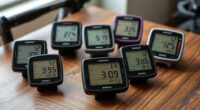To select the appropriate bicycle pump, consider portability, valve compatibility, and build quality for durability. Use a floor pump for accurate, quick inflation at home, and switch to hand pumps or CO2 inflators when on the go. Always check your tire’s sidewall for recommended PSI, and use a reliable gauge to monitor pressure. Proper inflation prevents damage and ensures safe riding—keep exploring for more tips to master tire care and maintenance.
Key Takeaways
- Select a pump compatible with your valve type (Schrader or Presta) and suitable for your inflating needs (portable hand pump, floor pump, or CO2 inflator).
- Consider pump capacity, build quality, and features like pressure gauges for accurate, efficient tire inflation.
- Check tire sidewall markings for recommended PSI and use a reliable gauge to maintain proper pressure.
- Ensure proper pump attachment, secure seals, and monitor pressure during inflation to prevent over- or under-inflation.
- Regularly maintain your pump by checking for leaks, lubricating parts, and calibrating gauges for long-term reliable performance.
Understanding Different Types of Bicycle Pumps

Have you ever wondered which type of bicycle pump suits your riding needs best? Understanding different types of bicycle pumps is essential for proper pump maintenance and effective inflation techniques. Mazda Tuning highlights how specific upgrades can optimize vehicle performance, just as selecting the right pump can improve your cycling experience.
Hand pumps are lightweight and portable, perfect for quick repairs on the trail. Floor pumps, with their larger size and higher capacity, are ideal for home use and frequent inflation. CO2 inflators offer rapid inflation but are less durable long-term. To ensure reliable performance, it’s important to understand proper inflation techniques, which vary depending on the pump type and the tire’s requirements. Proper air pressure is crucial for optimal ride quality and safety.
Each type requires specific inflation techniques; for example, hand pumps demand a steady rhythm, while floor pumps need a secure seal to prevent air loss. Knowing the strengths of each pump helps you choose the right one and guarantees your tires stay properly inflated, whether you’re riding locally or setting out on a long-distance adventure.
Factors to Consider When Selecting a Bike Pump
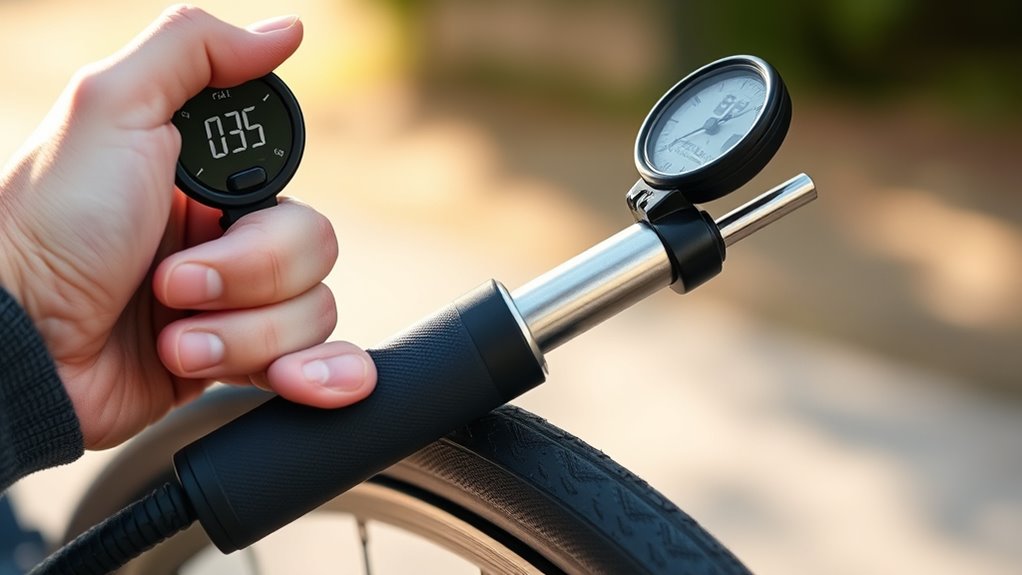
When choosing a bike pump, several key factors can influence which one will best meet your needs. Pump portability is essential—you want a lightweight, compact pump that’s easy to carry on rides or store in your bike bag.
Choosing a lightweight, compact pump ensures easy transport and storage during rides.
Consider inflation speed, especially if you frequently need to inflate tires quickly after flats or long rides. A pump with a high volume capacity will inflate tires faster, saving you time and effort. Additionally, recent advancements in machine learning algorithms have enabled smarter pump designs that can optimize inflation based on tire type and pressure requirements. These innovative features can also provide precise pressure control, ensuring your tires are inflated to the correct specifications every time.
Moreover, understanding valve compatibility is crucial to avoid improper fittings that could compromise inflation efficiency or damage valves. Also, think about the pump’s build quality and durability; a sturdy pump withstands regular use and rough handling. Compatibility is vital too—ensure the pump fits your valve type, whether Schrader or Presta.
Additionally, incorporating powerful persuasive words into your selection process can help you prioritize features that truly meet your needs and enhance your overall experience. In today’s landscape of automation in business, selecting the right pump can streamline your maintenance routine and improve your cycling efficiency.
Determining the Correct Tire Pressure for Your Bicycle
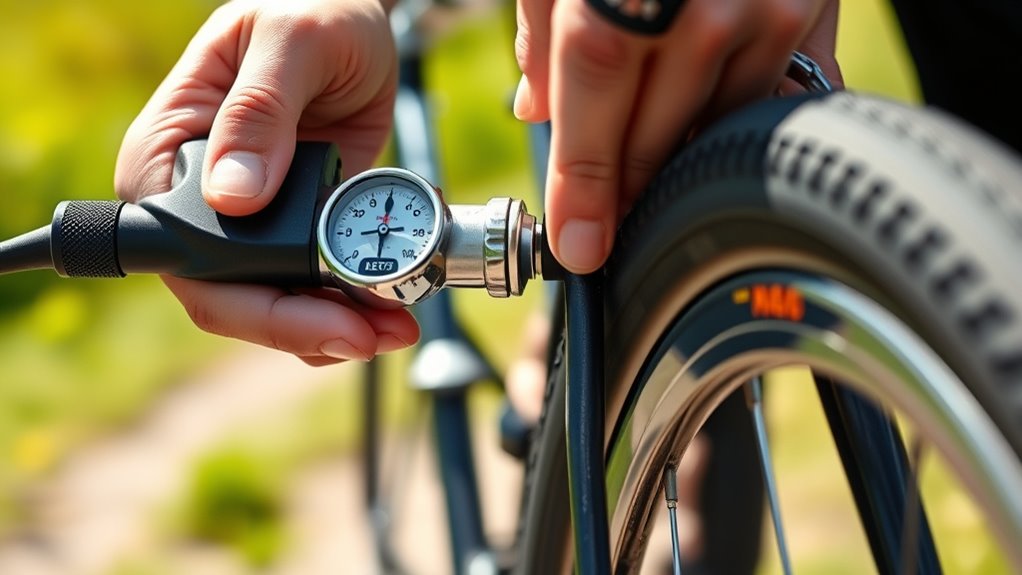
To find the right tire pressure, start by checking the number on the tire sidewall. Follow the manufacturer’s recommendations for ideal pressure, which guarantees a smoother ride. Use a reliable gauge to get an accurate reading every time. Ensuring the correct tire pressure can also improve the longevity of your tires and overall safety. Properly upgrading fixtures and hardware, such as valve stems, can contribute to maintaining consistent pressure levels. Additionally, maintaining proper air quality within your tires can prevent damage and reduce the risk of flats. Being aware of narcissistic traits in your bike maintenance routine can help you stay attentive to all aspects of your bike’s health. Remember, consistent fatherhood practices like regular checks can lead to a more enjoyable and safe cycling experience.
Check Tire Sidewall
Ever wonder how to find the right tire pressure for your bicycle? The answer lies on the tire sidewall, where you’ll see inflation markings. These markings indicate the recommended pressure range for your tire, usually given as a minimum and maximum PSI. Checking the manufacturer’s guidelines on the sidewall ensures you’re inflating your tires to a safe and optimal level.
Be aware that some tires may also include digital literacy programs to help you interpret these markings more easily. Check these numbers carefully to determine the *best* pressure for your ride. Keep in mind that the tire sidewall provides the manufacturer’s guidelines, which *guarantee* safe and efficient riding.
Understanding proper inflation techniques can help you maintain your tires more effectively and extend their lifespan. Avoid inflating your tires beyond the maximum or below the minimum markings, as both can cause issues like flats or poor handling. By noting these inflation markings, you’ll have a clear reference point to set your pump correctly and keep your tires properly inflated.
Follow Manufacturer Recommendations
Following your bicycle manufacturer’s recommendations is the most reliable way to determine the correct tire pressure. Check your bike’s sidewall or owner’s manual for the recommended PSI range. This guidance ensures you optimize riding performance and safety. Additionally, selecting the appropriate best beaches can enhance your outdoor experience and provide a more enjoyable ride or outing. Proper pump maintenance, like keeping your pump clean and functioning correctly, helps achieve accurate inflation. Remember, inflation techniques matter; use a pump that applies steady pressure without over- or under-inflating. Using a reliable pump gauge can help you monitor pressure accurately and prevent guesswork. Regularly inspecting and replacing worn-out airless paint sprayer tips can improve the quality of your paint job and prevent clogs, ensuring consistent paint flow. Maintaining proper tire pressure is essential for preventing fatigue and ensuring a smooth ride. Proper pressure monitoring is vital for consistent inflation and optimal performance. Always verify the recommended pressure before riding, and prioritize proper pump maintenance for accurate, safe inflation every time.
Use a Reliable Gauge
Using a reliable gauge is the best way to guarantee your tires are inflated to the correct pressure. Accurate pressure measurement ensures you get consistent pressure readings, which directly affects your riding experience and tire longevity. Proper gauge calibration and pressure accuracy help you maintain ideal tire pressure, enhancing safety, comfort, and performance. Regularly check and calibrate your gauge to maintain its accuracy. When inflating, always verify the pressure with this gauge, especially if your pump’s built-in gauge isn’t trustworthy. Proper measurement techniques are essential for effective tire inflation and maximizing your cycling safety and efficiency. Maintaining accurate pressure helps prevent issues like flats or poor handling. Don’t skip this step—reliable measurements are essential for effective tire inflation.
How to Properly Use a Floor Pump for Accurate Inflation
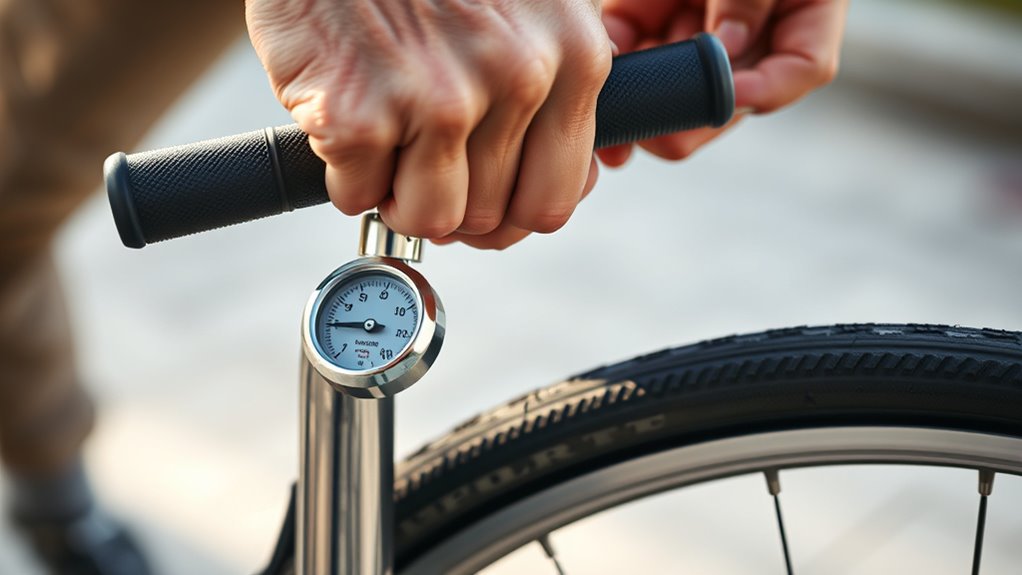
To guarantee your bike tires are inflated accurately, you need to understand how to properly use a floor pump.
First, ensure the pump is well-maintained; check the hose and seal for cracks or leaks to prevent air loss.
Attach the pump head securely to the valve, whether Schrader or Presta, to ensure a proper seal.
As you pump, monitor the pressure gauge closely, stopping periodically to prevent over-inflation.
Proper tire sealing is vital; a loose connection can lead to inaccurate readings and tire deflation.
After reaching the desired pressure, quickly detach the pump head to maintain pressure inside the tire.
Regular pump maintenance keeps your equipment reliable, and careful handling during inflation ensures your tires stay properly sealed and inflated for optimal performance.
Tips for Using Hand Pumps and CO2 Inflators Effectively

When inflating your tires with hand pumps or CO2 inflators, paying attention to proper technique can make a big difference in achieving accurate pressure and avoiding damage. For hand pump techniques, ensure you keep a steady, consistent stroke to prevent tire blowouts or leaks. With CO2 inflators, prioritize co2 inflator safety by controlling the release to avoid over-inflation. Always check your tire pressure before and after inflation to confirm accuracy. Use the table below to guide your technique:
| Hand Pump Techniques | CO2 Inflator Safety |
|---|---|
| Maintain steady strokes | Release slowly |
| Keep valve sealed properly | Use protective gloves |
| Avoid over-pumping | Store cartridges safely |
Mastering these tips guarantees quick, safe, and accurate inflation every time.
Recognizing When Your Tires Are Properly Inflated
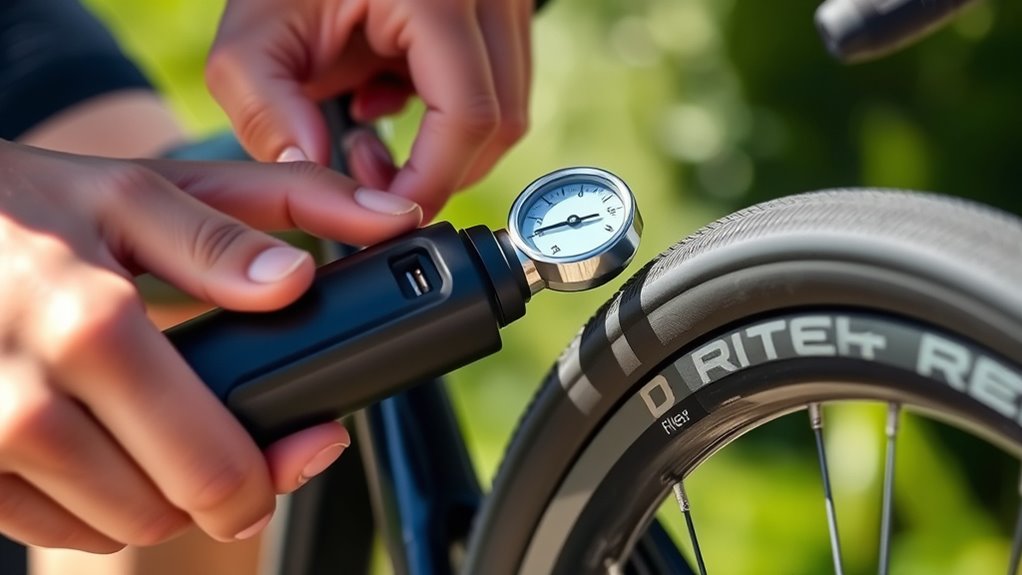
To know when your tires are properly inflated, start with a visual check for any flat spots or bulges.
Listen closely for hissing sounds that may indicate a leak, and use a pressure gauge to confirm the exact PSI.
These simple steps help make certain your tires are safe and ready for your ride.
Visual Tire Inspection
A quick visual check can often reveal if your tires are properly inflated. Start by examining the tire tread; it should be evenly worn and not bulging or sagging. Look for any deformities or cracks that might indicate under-inflation or damage.
Next, inspect the valve types—whether Schrader or Presta—making sure they’re securely closed and free of leaks. Properly inflated tires usually have a firm, rounded shape without noticeable dents or flattening at the contact patch.
If the tire appears saggy or deformed, it’s a sign you should inflate it. Regular visual inspections help catch issues early, ensuring your tires maintain the right pressure for safe, efficient riding.
Listening for Hissing Sounds
Listening carefully for hissing sounds is an effective way to know if your tire is properly inflated. When you hear a consistent hissing, it indicates a leak detection issue or that the tire isn’t sealed correctly. If the sound is faint, it might be a slow leak, so double-check your connection. To better understand, here’s a quick guide:
| Hissing Sound | What It Means |
|---|---|
| Steady | Possible leak; recheck connection |
| Faint | Slow leak; listen closely |
| Sudden | Rapid leak; stop inflating |
| No sound | Likely sealed properly |
| Intermittent | Check for leaks or loose fittings |
Use your ears as a simple tool to ensure your tires are inflated correctly and avoid flat tires or blowouts.
Using a Pressure Gauge
Ever wonder how to be sure your bike tires are inflated to the right pressure? Using a pressure gauge is key. First, check the gauge’s calibration—if it’s inaccurate, your readings won’t be reliable. Regularly calibrate your gauge to guarantee gauge accuracy.
When inflating, attach the gauge firmly to the valve and read the pressure. Aim for the recommended PSI printed on your tire sidewall. Keep an eye on the gauge during inflation to avoid over- or under-inflating.
Once you reach the target pressure, remove the gauge and double-check. Accurate readings depend on a well-calibrated gauge, so invest in a quality one and verify its accuracy periodically.
Properly inflated tires improve riding comfort and safety, making your ride smoother and more efficient.
Common Mistakes to Avoid During Tire Inflation
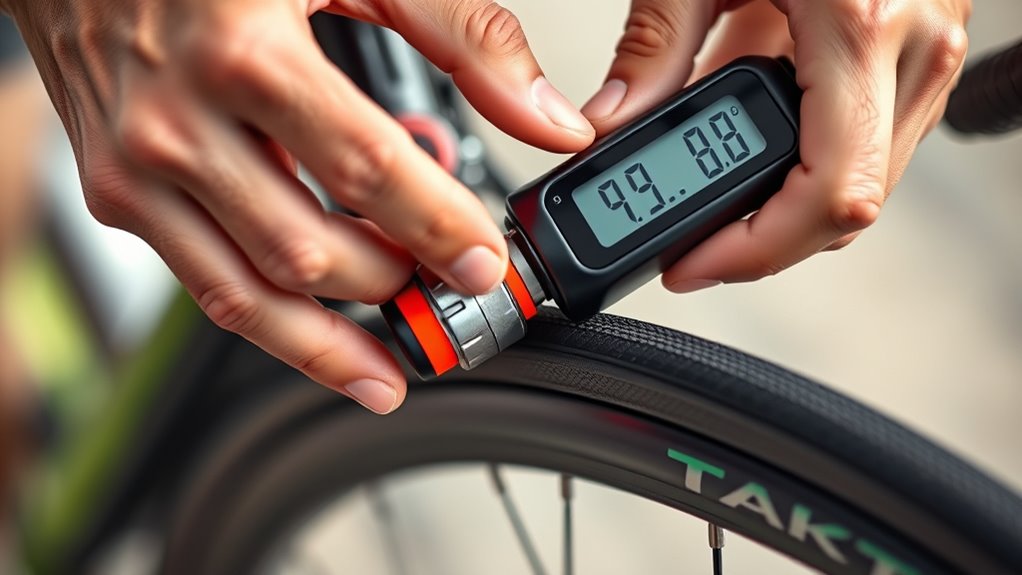
Many cyclists make the mistake of overinflating or underinflating their tires, which can lead to damage or poor performance. Overinflation hazards include a harsh ride and increased risk of blowouts, while underinflating causes sluggish handling and pinch flats. To avoid these issues, ensure your pump matches your valve type and use a pressure gauge for accuracy.
| Tip | Explanation |
|---|---|
| Check valve compatibility | Use the correct pump head for your valve to prevent leaks. |
| Avoid overinflation | Follow recommended PSI to prevent tire damage. |
| Use a pressure gauge | Always monitor pressure during inflation. |
| Inflate gradually | Prevent sudden overinflation or underinflation. |
| Double-check pressure | Confirm your tires reach the ideal PSI for riding. |
Maintaining Your Bicycle Pump for Long-Term Use
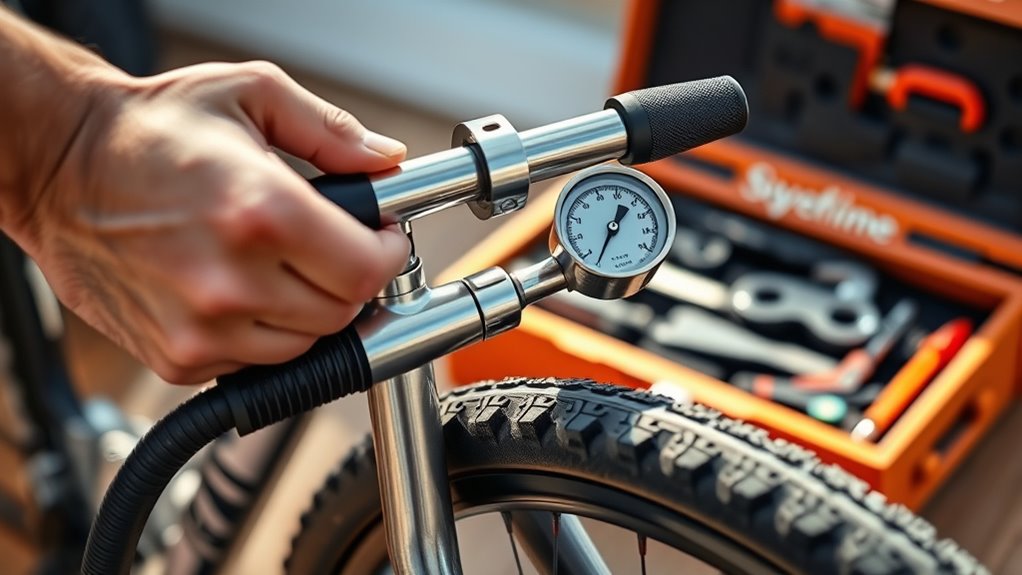
Regularly maintaining your bicycle pump guarantees it stays reliable and efficient over time. Pump maintenance involves checking for leaks, lubricating moving parts, and ensuring the hose and nozzle are free of damage.
Keep the pump clean and dry after each use to prevent dirt and moisture from causing corrosion. Proper storage techniques are essential; store your pump in a cool, dry place away from direct sunlight and extreme temperatures.
Avoid leaving it outdoors or in damp areas, which can degrade seals and internal components. If your pump has a pressure gauge, periodically test it for accuracy and recalibrate if needed.
Regular upkeep ensures your pump functions smoothly when you need it most, extending its lifespan and maintaining ideal performance for years to come.
Practical Tips for Safe and Efficient Tire Inflation

To guarantee safe and efficient tire inflation, start by checking the recommended pressure listed on your tire’s sidewall. Use tire pressure units your pump supports, whether PSI, bar, or kPa, to verify accuracy.
Before inflating, inspect your bike pump for proper maintenance—tighten fittings and check for leaks. When pumping, apply steady, even pressure to avoid damaging the valve or overinflating.
Keep an eye on the pressure gauge as you work, stopping once you reach the recommended PSI. Remember, overinflating can cause punctures, while underinflating affects ride quality.
Regular bike pump maintenance ensures consistent performance, making inflation safer and faster. Proper technique and equipment care help you achieve ideal tire pressure efficiently, keeping your ride smooth and safe.
Frequently Asked Questions
Can I Use a Car Air Compressor to Inflate Bicycle Tires?
You can use a car compressor to inflate bicycle tires, but you need to take into account tire compatibility. Car compressors produce higher pressure and airflow, which can overinflate or damage your bicycle tires if you’re not careful.
Check your bike’s recommended pressure and ensure the compressor has the right fittings. Using a car compressor is convenient, but always monitor the pressure closely to avoid overinflation and potential tire damage.
How Often Should I Check Tire Pressure During Rides?
Imagine you’re preparing for a long ride; during pre-ride checks, you should verify tire pressure. You might check it again halfway through your ride, especially on rough terrain or hot days.
Consistent pressure maintenance ensures safety and efficiency. Generally, you should check your tire pressure at least once during your ride, or more often if conditions change.
This keeps your tires at ideal pressure, preventing flats and improving performance.
Is It Safe to Overinflate Bicycle Tires Temporarily?
Overinflating bicycle tires temporarily isn’t safe because of overinflation risks. It can cause your tires to burst or blow out unexpectedly, especially on rough terrains or if the pressure exceeds the tire’s recommended limit.
For tire pressure safety, always check your tire’s maximum pressure and stay within that range. While a slight overinflation might improve rolling resistance briefly, avoid doing it regularly to prevent damage and guarantee your safety.
What Are Signs My Pump Needs Maintenance or Replacement?
Your pump’s health is vital; ignoring signs could cause it to fail completely. If you notice inconsistent tire pressures, it might be time for pump calibration.
Leaking around the valve or difficulty reaching desired pressure signals valve integrity issues. Also, examine for cracks or worn parts.
Regular maintenance keeps your pump in top shape, preventing sudden breakdowns on the trail. Stay vigilant—your ride depends on it!
Can Temperature Changes Affect My Bicycle Tire Pressure?
Temperature impact can cause tire pressure fluctuations, so you’ll notice pressure drops in cold weather and rises in warm conditions.
As temperatures change, air expands or contracts inside your tires, affecting their pressure.
You should check and adjust your tire pressure regularly, especially during seasonal shifts.
Conclusion
Just like tuning a musical instrument, inflating your bike tires to the right pressure guarantees a smooth ride. I once neglected this, and my punctured tire taught me the importance of proper inflation—every bump felt like a discordant note. By choosing the right pump and maintaining correct pressure, you’ll keep your ride harmonious and safe. Remember, a well-inflated tire is the foundation of a confident, enjoyable journey.

